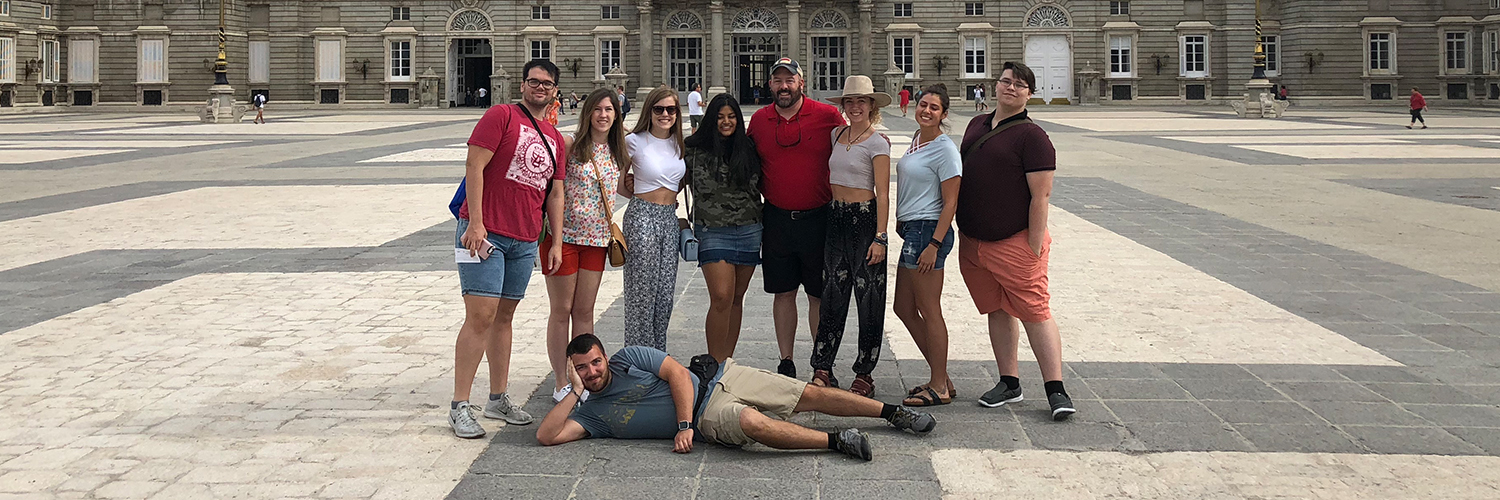
Spain
Program Dates: May 31-June 30, 2026
About / Important Dates / Courses / Program Costs / Itinerary / Apply Now
*The 2026 Spain trip is full. To be added to the waitlist, submit your application and deposit. Please refer to our waitlist policy for more information.
Pack your bags because you’re about to spend a month soaking up the language, flavor, and flair of Spain! From the buzzing boulevards of Madrid to the storybook streets of Toledo, you’ll dive headfirst into Spanish culture and earn course credit while you’re at it! You’ll live and learn in the charming town of Alcalá de Henares. Through the Franklin Institute of the University of Alcalá, you can choose from a wide variety of courses that explore Spanish literature, art, food, medicine, history, culture, and even translation. Come for credit. Stay for culture. Leave with memories.
Pre-requisites: SPAN 1001, 1002, 2001
International Travel & Health Information
Faculty Spotlight: Dr. John Giblin
Important Dates
$200 Deposit & Application Deadline
- December 3, 2025
1st Payment Deadline ($3,650)
- January 7, 2026
2nd & Final Payment Deadline ($3,650)
- February 5, 2026
SAO Orientation (mandatory)
- April 24, 2026 at 1:30PM
Contact Us
Study Abroad Office
Summerville Campus
Suite 251
Courses Offered
SPAN 3950 - Studies in Hispanophone Culture: Spain Today (3 credits)
2 courses at Alacala (6 credits) - Click here to learn more
Program Leader: Dr. John Giblin
Program Cost
All meals are included.
Application Deposit: $200
Deposit Due: 12/03/2025
Program Fee: Approx. $7,500 (includes deposit)
Final Payment Due: 02/05/2026
Tuition & Fees: based on number of credit hours enrolled
Itinerary subject to change
01
JuneDay One
Students arrive in Madrid and are welcomed at the airport before traveling to their host city, Alcalá de Henares. After check-in, students can rest and begin acclimating to Spanish life.
02
JuneDay Two
Morning orientation sessions introduce students to the university, Spanish culture, and program expectations. Later, a guided tour of Alcalá de Henares highlights the city’s rich history and UNESCO status.
03
JuneDay Three
Academic coursework begins and runs daily from 9:00 AM to 2:30 PM with a mid-morning break. Afternoons and evenings are free for cultural activities, local exploration, study, or personal time.
04
JuneDay Four
Academic coursework begins and runs daily from 9:00 AM to 2:30 PM with a mid-morning break. Afternoons and evenings are free for cultural activities, local exploration, study, or personal time.
05
JuneDay Five
Full-day excursion to Madrid. Students explore key landmarks and deepen their understanding of the capital’s cultural and historical significance.
06
JuneDay Six
Free days for rest, exploration, or optional cultural experiences.
07
JuneDay Seven
Free days for rest, exploration, or optional cultural experiences.
08
JuneDay Eight
Classes continue on the regular schedule from 9:00 AM to 2:30 PM. Students deepen their academic understanding while enjoying opportunities to engage with the local environment.
09
JuneDay Nine
Classes continue on the regular schedule from 9:00 AM to 2:30 PM. Students deepen their academic understanding while enjoying opportunities to engage with the local environment.
10
JuneDay Ten
Classes continue on the regular schedule from 9:00 AM to 2:30 PM. Students deepen their academic understanding while enjoying opportunities to engage with the local environment.
11
JuneDay 11
Classes continue on the regular schedule from 9:00 AM to 2:30 PM. Students deepen their academic understanding while enjoying opportunities to engage with the local environment.
12
JuneDay 12
Excursion to Segovia. Students will visit iconic sites including the Roman aqueduct, Gothic cathedral, and Alcázar palace.
13
JuneDay 13
Free days for rest, independent travel, or local activities.
14
JuneDay 14
Free days for rest, independent travel, or local activities.
15
JuneDay 15
Classes resume.
16
JuneDay 16
Classes resume.
17
JuneDay 17
Classes resume.
18
JuneDay 18
Classes resume. Students complete mid-term exams in the morning and visit the renowned Prado Museum in Madrid in the afternoon.
19
JuneDay 19
Full-day excursion to Toledo, the “City of Three Cultures,” where students explore Spain’s interfaith and medieval heritage.
20
JuneDay 20
Open days for personal travel, cultural immersion, or relaxation.
21
JuneDay 21
Open days for personal travel, cultural immersion, or relaxation.
22
JuneDay 22
Academic instruction continues with regular class schedules and engaging classroom-based learning.
23
JuneDay 23
Academic instruction continues with regular class schedules and engaging classroom-based learning.
24
JuneDay 24
Academic instruction continues with regular class schedules and engaging classroom-based learning.
25
JuneDay 25
Academic instruction continues with regular class schedules and engaging classroom-based learning.
26
JuneDay 26
Free days for local exploration, relaxation, or final review before the end of the program.
27
JuneDay 27
Free days for local exploration, relaxation, or final review before the end of the program.
28
JuneDay 28
Free days for local exploration, relaxation, or final review before the end of the program.
29
JuneDay 29
Final academic day. Students complete their last classes and begin preparing for departure.
30
JuneDay 30
Departure day. Students check out of their housing and the program officially concludes.